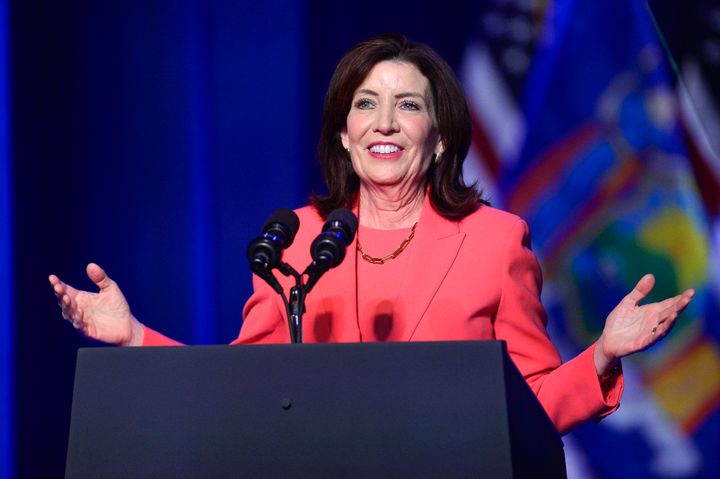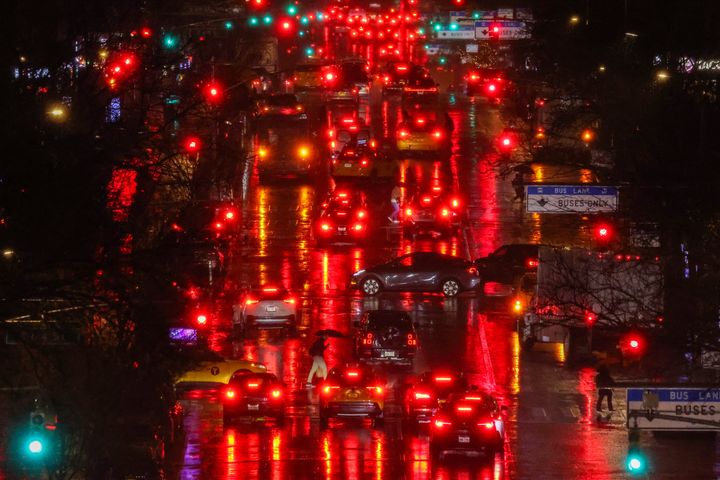Almost exactly one year ago, New York Gov. Kathy Hochul cast her state’s first-in-the-nation plan to make the drivers clogging Manhattan’s streets to help pay to fix the subways and buses that most New Yorkers depend on as a commonsense solution.
“As a mom, I’ve had to deal with sick kids a lot,” the Democrat said. When a child falls ill, prescribing a decongestant “opens up spaces in the body” she said, “helping people get well and live a healthier life.”
“That’s exactly what we’re doing here in the City of New York,” Hochul said. “We’re prescribing a decongestant.”
On Wednesday, with less than three weeks to go before the first dose, the governor abruptly halted New York City’s congestion pricing program, opening a $1 billion per year gap in the state budget for upgrading a transit system that has so far failed to keep pace with a growing population and increasingly extreme weather.
“Circumstances have changed,” she said in a pre-recorded address.

What remains constant, say critics of the move, is the governor’s sensitivity to pressure from local opponents of policies with statewide benefits.
“The whole thing is galactically stupid,” said Pete Sikora, a senior adviser to the climate and anti-poverty group New York Communities for Change. “It’s part of a pattern of this kind of flip-flop.”
Since assuming the Empire State’s highest office, Hochul has repeatedly embraced ambitious climate policies ― then bowed to political blowback.
In April 2022, the governor successfully bucked upstate opponents to push through a major transmission project connecting New York City and the hydroelectric system in Quebec, and recently beat 49 other states to launch the country’s first federally-backed rebate program for energy-saving home renovations.
But last year, Hochul sided with Long Island Republicans to veto legislation to get an offshore wind project off the ground. Around the same time, she signed legislation that may have violated federal law by caving to demands from anti-nuclear activists to block the company decommissioning the Indian Point nuclear plant from carrying out routine functions. That same year, she also carved the suburbs out of an increase to a tax that funds the state’s transit system.

As lieutenant governor in 2019, she oversaw the passage of New York’s landmark climate law. As governor in 2023, she proposed changing the statute’s method for calculating methane emissions in a way that would downplay the gas’ most dangerous effects on warming. Amid backlash, she backed down again.
After making waves with a plan to mandate the suburbs that benefit from the state’s costly commuter rail network shoulder their share of the growing population by building more apartments, she abandoned that strategy, too, amid fears of electoral blowback in the 2024 election.
But congestion pricing promised to enshrine a climate legacy for Hochul by clearing a path for the rest of the country to adopt one of the most straightforward ways to reduce planet-heating pollution from the No. 1 U.S. source of emissions: charging drivers to make trains and buses function better. If such a policy can’t make it in America’s densest and least car-dependent city, can it make it anywhere?
Given Hochul’s vocal support for congestion pricing, however, Wednesday’s reversal stunned advocates.
“Sometimes you get rumors things like this are in the works, but not this time,” said Kate Slevin, executive director of the Regional Plan Association, a nonprofit advocating for modernizing the New York transit system. “It was a shock.”
“To go from that, to this, is just absolutely head-spinning. One hates to use the word betrayal or perfidy.”
- Charles Komanoff, energy analyst and advocate of congestion pricing
When Charles Komanoff saw Hochul speak in support of congestion pricing in Manhattan’s Union Square last December, he said “she was able to make the case very clearly and unequivocally, unapologetically and with a kind of homemade eloquence that I was really taken with.”
“To go from that, to this, is just absolutely head-spinning,” said the New York-based energy analyst and national expert on congestion pricing.
“One hates to use the word betrayal or perfidy,” he added. “But it’s kind of hard to comprehend, because she had already taken a certain amount of a political hit from being down with and for congestion pricing.”
Opponents depicted the toll as a shakedown of outer-borough and suburban drivers from less ritzy parts of New York with few good options but cars to get anywhere on time, and complained that seniors and the working class would face the worst impacts. Supporters, however, pointed out that nearly 56% of households in the five boroughs do not own a car, and said if someone can afford to pay more for the transit system, it’s those with the income to register, insure and park an automobile in New York City.
The debate over the policy had raged for nearly a decade by the time Hochul, who had no real role in passing the legislation to establish the program, took up championing congestion pricing. While there were no other U.S. examples to point to, peer-reviewed research published last year that looked at public opinion in the largest jurisdictions to implement congestion pricing so far ― including London, Stockholm, Singapore and Edinburgh ― found that support grew after the policies took effect.
“This program is difficult. It’s been controversial,” Slevin said. “But in terms of what’s best for the largest number of people, congestion pricing is it, because it brings air quality benefits, it brings lower traffic benefits and it brings transit improvements to the entire city.”
Once traffic eased in Manhattan’s streets, air quality improved and the cash-strapped Metropolitan Transportation Authority made tangible upgrades to service, the extra charge to drivers would become as normal as the tolls Brooklynites pay to drive over the Verrazzano Bridge into Staten Island.
Hochul just needed to cross the proverbial “political valley of death,” Komanoff said, referring to the period between when a policy is passed and when its benefits kick in during which the program’s proponents are open to attack. New York’s congestion pricing has had to traverse a particularly long valley. While the British and Swedish capitals waited only a few months to implement their programs, New York’s government began supporting the policy seven years ago, when then-Gov. Andrew Cuomo called congestion pricing “an idea whose time has come.”
Yet the policy survived ― until now. Technically Hochul opted to “indefinitely pause” the program. If Donald Trump wins the presidency, however, the Republican is expected to reverse federal approvals for New York’s congestion pricing, potentially permanently unwinding the policy.
The governor’s office did not respond to emailed questions on Wednesday.
“You want to believe she’s been urged by staff and advisers, ‘steal yourself, governor,’” Komanoff said. “We’re there, 25 days away. And you’re giving up? You’re turning tail? It doesn’t make sense.”
Disclaimer: The copyright of this article belongs to the original author. Reposting this article is solely for the purpose of information dissemination and does not constitute any investment advice. If there is any infringement, please contact us immediately. We will make corrections or deletions as necessary. Thank you.
